How to Decorate a Christmas Tree with Ribbon
From simple flourishes to garland that wows, here are the best ways to incorporate ribbon into your Christmas tree.
It’s beginning to look a lot like Christmas, and we’ve got the trees to prove it. Where to start decorating is entirely up to you, but if ribbon is in your tree’s future, consider it a foundational element of the room's decor. Getting your tree's ribbon right can create a canvas that’s ready for ornaments, decorative branches, whimsical flourishes, and more.
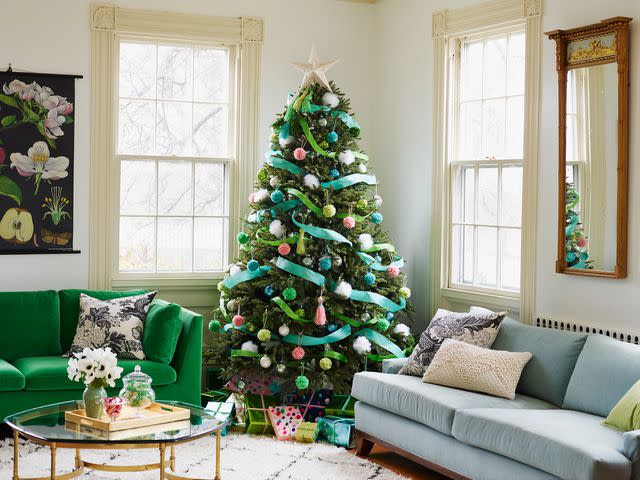
ALEXANDRA GRABLEWSKI
Here, Joshua Jones, creative director of Cavalier and Company, shares his top tips for wrapping a Christmas tree in ribbon, plus fresh ways to put spools to use on your spruce this holiday season.
Related: The 7 Best Artificial Christmas Trees of 2023 to Deck the Halls This Season

Cavalier and Company
How to Wrap a Christmas Tree in Ribbon
“It’s all about movement when layering stems, branches, and (of course) ribbon,” says Jones. When using ribbon in a Christmas tree design, the designer says it’s always the first element that goes on the tree. “The placement of the ribbon begins to create the movement of the overall design and allows the remaining decor to fall into place within the open spaces of the branches,” he explains.
Here's how to wrap a Christmas tree in ribbon using the tuck, loop, tuck, tail technique.
Start at the top of the tree, tying the top of the ribbon to an internal branch.
Working vertically, wrap the tree by looping the tail out of the body of the tree, tucking it back in. If working with an artificial tree, you can use the wired branches as twist ties around the tuck point to secure the ribbon. For a live tree, use green floral wire to fix the tucked ribbon to the branch.
Repeat the tuck, loop, tuck technique as many times as desired. The overall effect should be more vertical than a true spiral around the tree, but it can gently curve around per your preference.
Create a finished look by cutting a dovetail in the trailing end of the ribbon.
Repeat steps 1 through 4 as many times as required to reach your desired effect.
Design Tip
If you’re not a bow pro, try creating single loops secured with wire, letting the long strand end in a dovetail. “Simply tuck these non-fussy bows into the tuck points of the existing ribbon,” Jones explains. “This extra step in your ribboning process will make you look like a design genius.”
Related: 9 Reasons Why It’s Never Too Early for Christmas Decorations
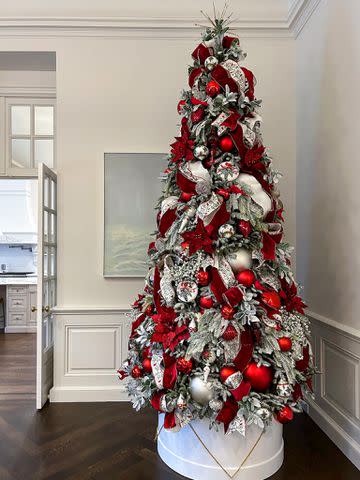
Cavalier and Company
How to Decorate a Tree with Ribbon and Ornaments
First comes ribbon, then come the embellishments like faux branches, extra bows, florals, and berries. After the tree's foundation has been set, it’s time to talk ornaments. “When it comes to ornaments, we’ve all been programmed to hunt down the tiniest, most modest little baubles, but I give you permission to think big,” says Jones. “While it is beautiful to add a finishing touch of delicate glass finials or small-scale Christmas balls to the branches for a curated look, we encourage readers to explore larger ornaments, too.”
Start by tucking the largest ornaments toward the bottom of the tree, deep inside the branches.
Wire ornaments with green floral wire to the branches rather than relying on the strings or silver hooks that come fixed to ornaments when you purchase.
Work your way up, selecting smaller ornaments as they climb toward the top. The smallest baubles should be hung toward the tip of the tree.
Related: How to Decorate a Christmas Tree in 3 Easy Steps
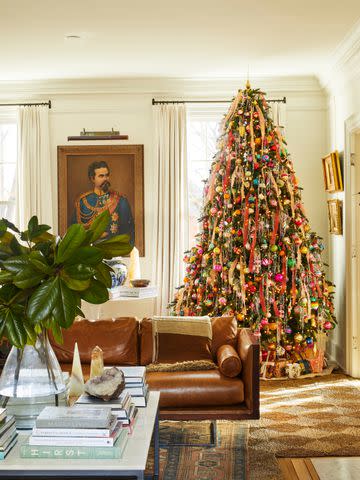
Annie Schlechter
Ideas for Decorating with Ribbon
The ways in which you can decorate your Christmas tree with ribbon are endless. Here, Jones shares his top tricks for making the most of your spools.
Select the Best Ribbon for the Job
“Nobody likes an uninspired, deflated ribbon,” says Jones. “To conquer that, we turn to wired ribbons that defy gravity and give our trees, garlands, and wreaths the festive lift they deserve.” Wired ribbons will give your design the structure and staying power it needs, while also adding volume and plenty of textural interest. “When looking at wired options, we determine the quantity and scale that is appropriate for the size of the tree, a color palette that complements the overall creative story, and contrasting textures to give the final design visual interest,” Jones explains.
Use Multiple Ribbons
One simple ribbon just won’t do, especially when it’s meant to be star of the overall aesthetic. For situation such as these, Jones aims to have up to four various styles incorporated within the design. “The types of ribbons will vary based on the final application or visual goal,” says Jones. To find the right mix, create a type of bouquet as you go about the selection process, ensuring all the textures, colors, and sizes play harmoniously—before you start decorating.

Cavalier and Company
Mix Patterns and Textures
“Generally, a mixture of patterns and solid textures will make your tree more interesting,” says Jones. “For example, if we are designing a more traditional Christmas tree with classic jewel tones, I might select a handsome plaid-patterned wool ribbon as my color driver.” Next, he’ll choose a solid ribbon, maybe in a rich fabric like velvet, that draws on one of the colors found within the pattern. Finally, add a metallic woven or netted option to give more unique texture and complement the rest of the display.
Select Colors Carefully
There’s no right or wrong way to go when it comes to color. Whether you want to play up contrast or take a more monochrome route, color selection is entirely up to preference, though there are certain tricks that can help ensure a cohesive look. For a high-contrast aesthetic, Jones suggests opting for colors that are complementary but on opposite ends of the color wheel, like mint green and deep red. Eye-catching patterns can also help deliver a splash. If you prefer colors that take a more subdued approach, aim for colors that are similar in tones for a more monochromatic look, "such as silver paired with a cool white, warm greens with festive golden hues, or a wintry mix of blue tones ranging from navy to aquamarine."
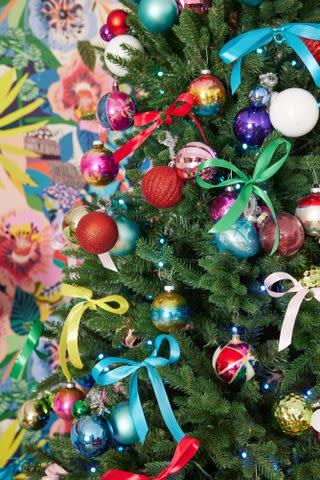
David Land
Skip the Bow if You’re Not Confident in Your Skills
If you’re not a bow-making pro, no need to fret. There are plenty of flourish options that can see to it that you avoid struggling with looping, swooping, and pulling. “Festive faux floral stems, silk poinsettias, berry branches, and flocked foliage can do wonders for a tree by introducing texture and volume,” says Jones. “Tuck your branches in a downward sweeping motion in the areas between your ribbon placement and place your floral stems in your ribbon’s tuck points.” Jones explains that most artificial tree branches and faux stems have internal wire that can be manipulated to look more natural. Play with their orientation until it feels and looks just right.
Related: How to Make a Bow Out of Ribbon in 4 Easy Steps
Opt for a Garland
Mix and match garland with ribbon to create an opulent effect. Jones suggests ball garlands as a way to add ornamentation while echoing the sweeping aesthetic of ribbon. “These garlands can be used to tuck along the trails of ribbon or replace ribbon altogether,” he explains.
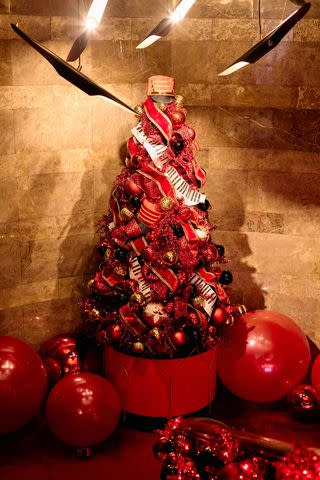
Timothy Musho/LightLeak Pictures
Think Outside the Box
While structured ribbons in beautiful patterns can add texture and interest, so too can more unconventional products that mimic a similar, wrapped effect. Jones and his team used paper piano key practice sheets to keep with this tree’s theme. “It takes some patience, but some careful bending and curling to the paper gave this Toyland Nutcracker tree a whimsical look,” he explains.
Throw Out the Rules
“The truth is that there are no rules,” says Jones. “Don’t be afraid to experiment, watch tutorials, or find helpful inspiration from the social media pages of professional designers.” Disregard your preconceived notions, take a trial-and-error approach, and enjoy the process. Make the task of decorating your tree a fun one and you’ll be rewarded with happy holiday memories and a tree you’re proud of.
For more Better Homes & Gardens news, make sure to sign up for our newsletter!
Read the original article on Better Homes & Gardens.

